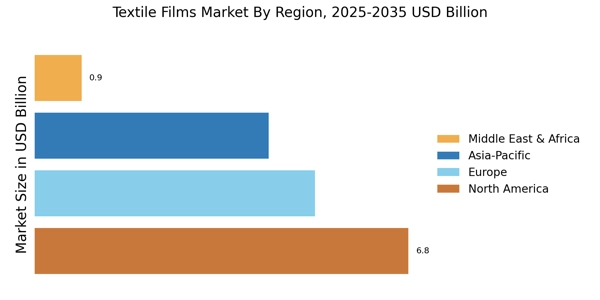Technological Innovations
Technological advancements are playing a pivotal role in the evolution of the Textile Films Market. Innovations in manufacturing processes, such as advanced extrusion techniques and coating technologies, are enhancing the performance and functionality of textile films. These technologies enable the production of films with superior properties, including increased durability, flexibility, and resistance to various environmental factors. Furthermore, the integration of smart technologies, such as sensors and conductive materials, is opening new avenues for applications in sectors like healthcare and automotive. The market is witnessing a surge in demand for high-performance textile films, with projections indicating a potential market size exceeding USD 10 billion by 2027. This technological evolution is not only improving product offerings but also driving competition within the Textile Films Market.
Sustainability Initiatives
The increasing emphasis on sustainability within the Textile Films Market is driving demand for eco-friendly materials. Manufacturers are increasingly adopting biodegradable and recyclable films to meet consumer preferences for sustainable products. This shift is not merely a trend but a response to regulatory pressures and consumer awareness regarding environmental issues. As a result, the market for sustainable textile films is projected to grow significantly, with estimates suggesting a compound annual growth rate of over 5% in the coming years. Companies that prioritize sustainability are likely to gain a competitive edge, as consumers are more inclined to support brands that align with their values. This focus on sustainability is reshaping the Textile Films Market, encouraging innovation and the development of new materials that minimize environmental impact.
Customization and Specialization
The demand for customized solutions is becoming increasingly pronounced within the Textile Films Market. As industries seek to differentiate their products, the need for specialized textile films tailored to specific applications is on the rise. This trend is particularly evident in sectors such as automotive, where films are required to meet stringent performance standards. Manufacturers are responding by developing bespoke solutions that cater to unique customer requirements, thereby enhancing their market position. The customization trend is expected to contribute to a notable increase in market share for specialized textile films, with estimates suggesting a growth rate of around 6% annually. This focus on customization not only meets consumer needs but also fosters innovation within the Textile Films Market, as companies strive to create unique offerings that stand out in a competitive landscape.
Rising Demand in Emerging Markets
Emerging markets are witnessing a surge in demand for textile films, significantly impacting the Textile Films Market. As economies develop, there is an increasing need for advanced packaging solutions, automotive components, and medical applications that utilize textile films. Countries in Asia and Latin America are particularly driving this growth, with projections indicating that these regions could account for a substantial portion of the market share by 2030. The rising disposable income and changing consumer preferences in these regions are contributing to the demand for high-quality textile films. This trend presents opportunities for manufacturers to expand their operations and invest in local production facilities, thereby enhancing their presence in the Textile Films Market. The potential for growth in these emerging markets is substantial, suggesting a promising future for textile film manufacturers.
Regulatory Compliance and Standards
The Textile Films Market is increasingly influenced by regulatory compliance and standards that govern product safety and environmental impact. Governments are implementing stringent regulations regarding the use of certain materials and the disposal of textile films, prompting manufacturers to adapt their practices accordingly. Compliance with these regulations not only ensures market access but also enhances brand reputation among environmentally conscious consumers. The need for compliance is driving innovation, as companies invest in research and development to create films that meet or exceed regulatory requirements. This focus on compliance is expected to shape the future of the Textile Films Market, as businesses that proactively address these challenges are likely to thrive in a competitive landscape. The potential for regulatory-driven innovation could lead to the development of safer, more sustainable textile films, further influencing market dynamics.


















Leave a Comment